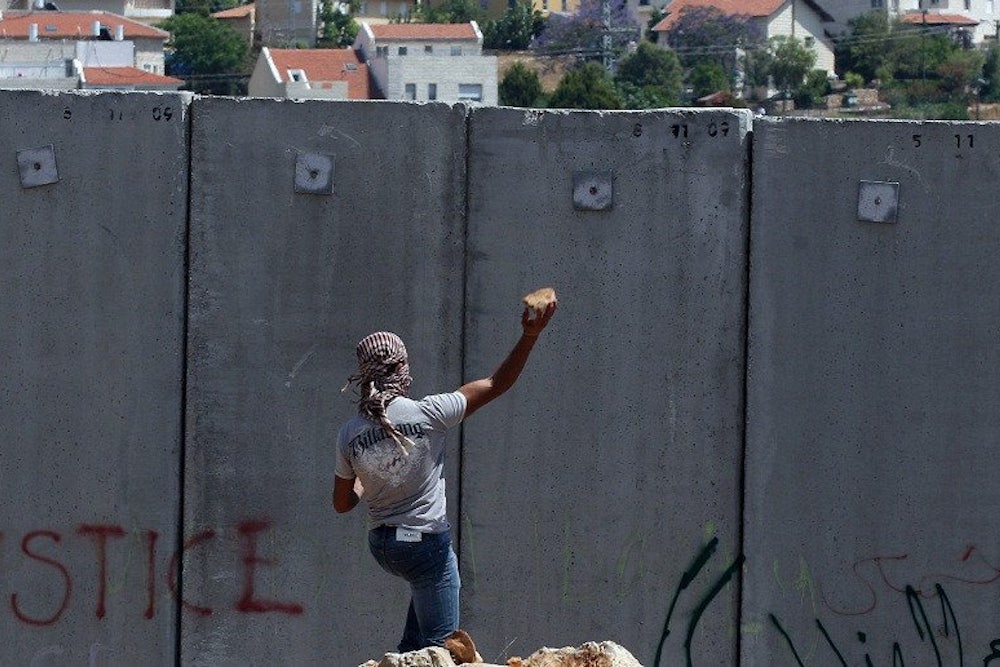In January, the government of Israel announced that it plans to build a fence along its frontier with Syria, because the Syrian army appears to have receded from the border area and jihadist forces have moved in. It is no wonder that the anarchy and the atrocity in Syria causes consternation in Israel; but this announcement left me with a heavy heart for another reason. With the erection of this northern barrier, Israel will be almost completely fenced in. The fences—in their most prominent locations, the high concrete slabs—that demarcate Israel from the Palestinians to the east are the most famous, or infamous, of these partitions; originally Yitzhak Rabin’s idea in the early 1990s, when “separation” was the regnant fantasy of Israel’s doves, it was begun in earnest in 2002, and 62 percent of its projected length of 440 miles has been completed. To the south, Israel has constructed a steel and wire barrier that runs the 150-mile length of its border with Sinai, which has now become a perilous and ungovernable waste. As it approaches the Mediterranean, this new fence will meet the old fence that Israel built around Gaza, 32 miles long with a buffer zone. Israel long ago put up a fence along its border with Lebanon. The only open border remaining—aside from the glistening apolitical sea to the west—is with Jordan to the southeast, from the Dead Sea to the Red Sea. The state is walled.
There are two ways to understand these comprehensive fortifications. The first is that they make Israel safer. Since the threats encircle Israel, the barriers encircle Israel. Their efficacy from the standpoint of security cannot be denied. The wall that runs north to south through the West Bank has spectacularly reduced Israel’s vulnerability to homicidal infiltrations, even if the barrier with Gaza has done nothing to deter the violence of the rockets that fly above it. Physical threats must be countered physically. (Israel is not the only country that has reached such a conclusion: the United States, India, South Africa, Saudi Arabia, Thailand, and other polities have also resorted to fences and walls.) It was not until Palestinian “resistance” chose to rely on suicide bombers that the big, cold wall was raised. A criticism of Israel’s “security fence”—the common Israeli appellation for what Palestinians call a “wall of racial separation”—that does not take seriously its success in thwarting terrorism cannot itself be taken seriously. Of course such criticisms abound: a wall between peoples is an ugly thing, though a massacre—and a strategy of massacre—is even uglier. About the racial character of the wall the Palestinians are wrong, but there is a second way, as I say, to understand the wall, and it has nothing to do with Israeli safety.
The argument from security cannot account for the precise contours of the partition. “Before I built a wall I’d ask to know / What I was walling in and walling out,” declares the most celebrated poem about fences, “and to whom I was like to give offense.” The West Bank wall denotes not only protection but also domination. A wall is an instrument of power, a political interpretation of space. It has two sides, and they are experienced differently. The wall has been cunningly drawn to include many Israeli settlements in the West Bank on the Israeli side of the line: it is a blunt premonition of sovereignty. It has also senselessly disrupted the communal and economic life of many Palestinians. If good fences make good neighbors, then bad fences make bad neighbors.
Are the barriers borders? What is temporary and what is permanent? The walls can be taken down, say the hopeful liberals. Maybe; but against this rational observation one must glumly note that Israel does not have a history of reversing itself, neither left-wing governments nor right-wing ones, in the West Bank. Most of the trouble in the world today is owed to the incommensurability of political borders with security borders, of political borders with cultural borders. It is ironic, no, it is tragic, that in an era of unprecedented mobility and migration the ideal of multi-ethnicity falls increasingly into disrepute; but almost everywhere one looks one sees a demand for ethnic clarifications and sectarian consolidations. Israel is a multi-ethnic society, whatever its jingoists say. There is no significant hunger in Israel for social or cultural homogeneity (except among the haredim and their ayatollahs), even if the state is dealing poorly with certain aspects of its heterogeneity. But the dead calm of Israel’s Palestinian policy, the ominous stagnation that is Benjamin Netanyahu’s contribution to the annals of his country’s diplomacy, is insanely shortsighted, a consequence of indifference abetting fanaticism. The humbling of Netanyahu in the recent election was delightful, but Yair Lapid is a passing phenomenon. His participation in the government will not alter its Palestinian policy. You cannot fight strong sentiments with weak sentiments. Lapid is new to the cause, if indeed he has joined it. He will merely provide more cover for more settlement and more drift.
The spectacle of the Jewish state behind walls is a melancholy sight. Historically and philosophically, it is a disappointment; and a failure, too, if you believe that Israeli action or inaction is responsible for some of the enmity—it is not remotely responsible for all of the enmity—that drives it to shut itself in. Of course Tel Aviv and its environs, the metropolitan miracle on the coast, is the antithesis of a confinement—it feels like the future, even if sometimes also like a fool’s paradise; and there is no wire and no concrete that cannot be digitally breached. Porousness comes in many forms. The notion that Israel is a ghetto is false and cheap. There is cosmopolitanism inside the enclosure. But Israel’s isolation is both voluntary and involuntary, a choice and a fate. Physical walls crumble more easily than mental walls.
